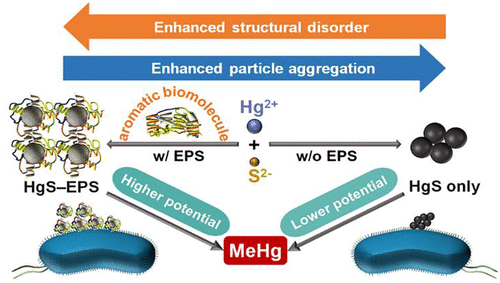当前位置:
X-MOL 学术
›
Environ. Sci. Technol.
›
论文详情
Our official English website, www.x-mol.net, welcomes your
feedback! (Note: you will need to create a separate account there.)
Effects of Extracellular Polymeric Substances on the Formation and Methylation of Mercury Sulfide Nanoparticles.
Environmental Science & Technology ( IF 10.8 ) Pub Date : 2020-06-08 , DOI: 10.1021/acs.est.0c01456 Zhanhua Zhang 1 , Rui Si 2 , Jitao Lv 3 , Yunyun Ji 1 , Wenshan Chen 1 , Wenyu Guan 1 , Yuxiao Cui 1 , Tong Zhang 1
Environmental Science & Technology ( IF 10.8 ) Pub Date : 2020-06-08 , DOI: 10.1021/acs.est.0c01456 Zhanhua Zhang 1 , Rui Si 2 , Jitao Lv 3 , Yunyun Ji 1 , Wenshan Chen 1 , Wenyu Guan 1 , Yuxiao Cui 1 , Tong Zhang 1
Affiliation

|
Growing evidence has suggested that microbial biofilms are potential environmental “hotspots” for the production and accumulation of a bioaccumulative neurotoxin, methylmercury. Here, we demonstrate that extracellular polymeric substances (EPS), the main components of biofilm matrices, significantly interfere with mercury sulfide precipitation and lead to the formation of nanoparticulate metacinnabar available for microbial methylation, a natural process predominantly responsible for the environmental occurrence of methylmercury. EPS derived from mercury methylating bacteria, particularly Desulfovibrio desulfuricans ND132, substantially increase the methylation potential of nanoparticulate mercury. This is likely due to the abundant aromatic biomolecules in EPS that strongly interact with mercury sulfide via inner-sphere complexation and consequently enhance the short-range structural disorder while mitigating the aggregation of nanoparticulate mercury. The EPS-elevated bioavailability of nanoparticulate mercury to D. desulfuricans ND132 is not induced by dissolution of these nanoparticles in aqueous phase, and may be dictated by cell–nanoparticle interfacial reactions. Our discovery is the first step of mechanistically understanding methylmercury production in biofilms. These new mechanistic insights will help incorporate microbial EPS and particulate-phase mercury into mercury methylation models, and may facilitate the assessment of biogeochemical cycling of other nutrient or toxic elements driven by EPS-producing microorganisms that are prevalent in nature.
中文翻译:

细胞外聚合物对硫化汞纳米颗粒形成和甲基化的影响。
越来越多的证据表明,微生物生物膜是生产和积累生物蓄积性神经毒素甲基汞的潜在环境“热点”。在这里,我们证明了生物膜基质的主要成分细胞外聚合物质(EPS)会显着干扰硫化汞的沉淀并导致可用于微生物甲基化的纳米颗粒间辰砂的形成,这是一个自然过程,主要负责环境甲基汞的发生。汞甲基化细菌特别是脱硫脱硫弧菌产生的EPSND132,大大提高了纳米微粒汞的甲基化潜力。这可能是由于EPS中丰富的芳香族生物分子通过内球络合与硫化汞强烈相互作用,从而增强了短程结构紊乱,同时减轻了纳米颗粒汞的聚集。纳米颗粒汞对脱硫D.尿菌的EPS升高的生物利用度这些纳米颗粒在水相中的溶解不是诱导ND132的原因,而可能是细胞-纳米颗粒的界面反应所决定的。我们的发现是机械理解生物膜中甲基汞生产的第一步。这些新的机制洞察力将有助于将微生物EPS和颗粒相汞纳入汞甲基化模型,并可能有助于评估自然界普遍存在的EPS生产微生物驱动的其他营养物质或有毒元素的生物地球化学循环。
更新日期:2020-07-07
中文翻译:

细胞外聚合物对硫化汞纳米颗粒形成和甲基化的影响。
越来越多的证据表明,微生物生物膜是生产和积累生物蓄积性神经毒素甲基汞的潜在环境“热点”。在这里,我们证明了生物膜基质的主要成分细胞外聚合物质(EPS)会显着干扰硫化汞的沉淀并导致可用于微生物甲基化的纳米颗粒间辰砂的形成,这是一个自然过程,主要负责环境甲基汞的发生。汞甲基化细菌特别是脱硫脱硫弧菌产生的EPSND132,大大提高了纳米微粒汞的甲基化潜力。这可能是由于EPS中丰富的芳香族生物分子通过内球络合与硫化汞强烈相互作用,从而增强了短程结构紊乱,同时减轻了纳米颗粒汞的聚集。纳米颗粒汞对脱硫D.尿菌的EPS升高的生物利用度这些纳米颗粒在水相中的溶解不是诱导ND132的原因,而可能是细胞-纳米颗粒的界面反应所决定的。我们的发现是机械理解生物膜中甲基汞生产的第一步。这些新的机制洞察力将有助于将微生物EPS和颗粒相汞纳入汞甲基化模型,并可能有助于评估自然界普遍存在的EPS生产微生物驱动的其他营养物质或有毒元素的生物地球化学循环。











































 京公网安备 11010802027423号
京公网安备 11010802027423号